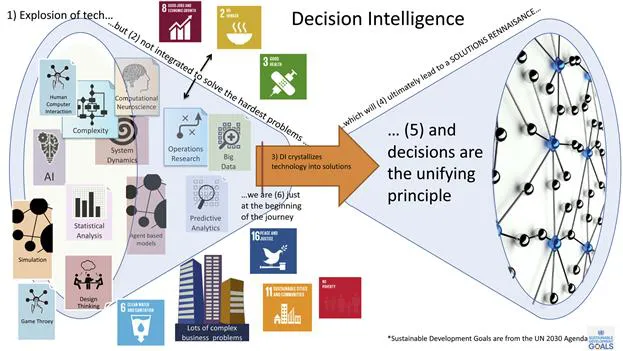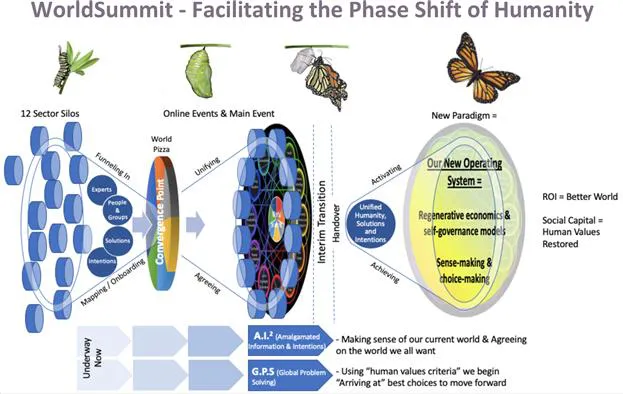![]()
CHAPTER 1
GETTING SERIOUS ABOUT DECISIONS
What’s the best way to begin to link technology and data with humans in this new world? Doing so can seem overwhelming, unbounded, and it’s hard to know where to start. Fortunately, a consensus is emerging worldwide that:
Key Insight #1: A decision – the thought process that leads to actions, which lead in turn to outcomes – is the right “building block” for solving many of the world’s most complex problems and for integrating humans with technology.
Why is this so? Everything you create or do happens twice: once when you visualize it and the second when you bring it into reality. And, when we visualize how our actions will lead to future outcomes, that visualization results in a decision.
This book is about how to think about decisions in a new way, which is connected to ancient patterns of thought, and is informed by unlimited sources of new information a greater ability to work together. The field is called decision intelligence (DI).
As I’ll describe in more detail later on, NASA uses DI to decide how to deflect an incoming asteroid [6]; Google’s chief decision officer Cassie Kozyrkov has trained thousands of engineers in DI [7]; DI is extending how AI is applied in the legal profession [8], and DI ecosystem members include enterprise tech giant SAP a greater smaller companies like Element Data [9] and Prowler [10].
SHIFTS IN PERSPECTIVE
To do this, you’ll need a shift in perspective: technology alone solves only a small subset of the important problems. It must work hand in hand with humans who in turn work in new collaborative settings, which integrate the academic disciplines with nonspecialists like you (because everyone is a nonspecialist in most areas) with technology, and with your friends – on social media and in person – who want to go beyond conversation.
This change in thought demands, in turn, a problem-focused position. Technology can be exciting, but it must come second; indeed, it can create huge distractions. For example, we may become so enamored with “smart” city sensor technology that we lose sight of the fact that simply improving human collaboration would lead to a better solution to the issues we face. By starting with problems and desired outcomes and then working backward to actions by way of data, artificial intelligence, human expertise, complex systems analysis, economic theory, and more, we obtain a greater focus, and problems become solvable in new ways.
Much as early telescopes were an important part of the shift in our understanding of the heavens, the focus that we obtain by tracing back from the outcomes we wish to achieve to the actions we take to achieve those outcomes, and then to the decision making thought process, drives a powerful change in a world that is otherwise looking for a technological “silver bullet.”
Another shift in thinking is from breaking problems into small parts – called reductionism or analysis – to understanding how those parts work together – called synthesis. Reflecting this movement, for example, an early pioneer is intelligence expert Josh Kerbel, who calls himself an “intelligence synthesist” instead of the more familiar term “intelligence analyst” [11].
You’ll also need to go beyond verbal and text-based thinking, to use the spatial and motor parts of your brain, which are older and, in many ways, smarter. In doing so, we’re integrating technologies not only with each other, but also with the management and social sciences in a powerful new way.
THE DI SOLUTIONS RENAISSANCE
The only way that we will be able to successfully address our grand challenges is through the practice of meshing. In our age of exponential complexity, one plus one does not always equal two. When we intentionally combine the various elements of art and science, we will discover new ideas and solutions. We have not solved some of our biggest problems because we have siloed our disciplines, and this granular approach has actually caused those problems to be exacerbated. The sweet spot of discovery is in the middle - the relationships between the disciplines […].
– Frank Spencer/Yvette Montero Salvatico
(Kedge/The Futures School [1])
The potential of DI cannot be overstated.
DI does not replace existing technologies. Indeed, it supercharges them by unifying them into a single framework. It also bridges them into a form that is familiar and natural to non-technical decision makers.
In addition, DI is today becoming a unifying framework within which a “solutions renaissance” is also emerging, promising to solve some of the most important problems we face, like poverty, climate, conflict, and more, as shown below in Figure 1.
Figure 1. A Solutions Renaissance, Driven by Decision Intelligence.
The left-hand side of Figure 1 shows several disciplines that have historically been explored separately: a game theorist may understand some AI, but not enough to use it effectively; an expert in Big Data may have never even heard of Operations Research. The challenge we face today is illustrated by the arrow in the center of Figure 1: to develop frameworks and other “glue” techniques to get these disciplines working together to solve the most important problems. And the overwhelming evidence is that decisions should be the focus.
But don’t take my word for it. Check out the very similar diagram produced by the team at http://www.worldsummit.global/phase-shift/ (Figure 2). Its similarity to mine speaks to the emerging consensus regarding the shift to a consolidation phase which is creating a new platform for solutions to wicked problems.
Figure 2. WorldSummit’s View of the Upcoming Human Phase Shift.
Source: WorldSummit.global.
Separating “Under the Hood” from “the Driver’s Seat” Allows Sophisticated Disciplines to be Unified
Unfortunately, one of the characteristics of specialist disciplines is that they accumulate jargon over time, which can appear daunting for a “neo-generalist” trying to support this endeavor [12]. Although jargon serves a purpose – it allows for shorthand communication by specialists – it interferes with the most important task today, which is to integrate the disciplines to solve wicked problems. Given that it’s impossible in one lifetime to learn the sophisticated language of so many individual fields, how can this be possible?
Fortunately, there’s a well-understood answer that comes from engineering disciplines: to focus on the “outside of the box” instead of the inside. As pointed out by Google Cloud Chief Decision Scientist (and DI evangelist) Cassie Kozyrkov: “We don’t have to be refrigeration experts nor microwave electronics experts to cook a good meal: instead we can interact with these kitchen appliances through easy-to-use interfaces [15].” And to enjoy eating the meal in a restaurant, we don’t need to know a thing about the “back of the house”: the kitchen and cooks who work there. Like Russian dolls, these complex systems are organized into layers. The connection between the layers is called an interface, the most well-known example of which is a user interface for a piece of software. Just as you don’t need to understand your iPad operating system or how to write software to enjoy Words with Friends, it turns out you don’t need to have a deep technical understanding to use an economic or artificial intelligence model.
The bottom line: don’t let the sophistication of your Ferrari stop you from driving it, and don’t let the jargon often used within AI or complex system dynamics stop you from making use of these technologies. The purpose of Chapter 3 is to build this bridge for you: to help you to understand these technologies so you can be part of the global movement to solve the wicked problems, if you like, or just those within your own life or organization.
An important side note: as a computer scientist and AI practitioner, I have a lot to say about AI, machine learning (ML), and software solutions. But don’t be misled: my greater focus on technology compared to, say, economics, is merely an artifact of my own expertise and experience. Please don’t take away from this emphasis that software is the most important element of the full DI discipline. It’s not.
The Solutions Renaissance in Context
The Copernican revolution was based on a shift from the Earth as the center of the Universe to the Sun as the center of the solar system. This simplified very complex equations for planetary motion and also formed the basis for centuries of understanding of our Universe [13]. As described by Kuhn, the Copernican revolution also represents a pattern for paradigm shifts: changes in perspective that bring about great benefits.
Shifting to a decision-centric perspective and using the decision as the basis for unifying multiple fields of study has the potential for as great an impact as Copernicus.
Complex adaptive systems, whether single-celled organisms, bacteria, or the Internet, undergo what might be called a “breathe out/breathe in” alternation: an explosion of programming languages is followed by consolidation into one or two … a period of great human exploration and creativity is followed by a consolidation into a few types of economy.
This rhythm of complex adaptive systems goes back millions of years (Howard Bloom calls the phases Diversity Generation/Conformity Enforcement [14]). The DI renaissance shown in Figure 1 fits this age-old pattern: an exciting journey for those bravely optimistic enough to believe in a bright future, driven by a phase shift in human potential.
Like other paradigm shifts, DI sheds light on complexity, providing insights and solutions that were not previously possible. Core to my approach to DI is a diagram I call the causal decision diagram (CDD). As I’ll describe in more detail below, the CDD is made up of just a few simple parts. Like DNA, these parts can be combined to find solutions of great sophistication.
HOW DID WE GET HERE: THE TECHNOLOGY HYPE FEEDBACK LOOP
To understand how to untangle ourselves from current circumstances, it’s important to understand some of the patterns that got us here. One is a technology hype feedback loop: the press looks for exciting stories, and technology solution vendors are much easier to reach for an interview than people with problems for the technology to solve. This leads to a lopsided media focus: we write about exciting technology, which then feeds back to technology companies, who use the press coverage to raise funds and plan strategically, which in turn leads to more availability for those press interviews.
This loop is exacerbated by the Internet and, despite the benefits of democratization of information, there are now massively powerful vectors of misinformation about topics like Big Data, Artificial Intelligence, Augmented Reality, Autonomous Vehicles, and more. But, says Google’s Chief Decision Scientist Cassie Kozyrkov, the Internet also:
expands access to information and allows people to peer over the silo walls that used to separate academic fields, creating an environment in which the interdisciplinary nature of Decision Intelligence can thrive [15].
THE CORE QUESTION
Amid all the complexity, visual archetypes help us connect globally with people on a basic human level.
– Eileen Clegg, the founder of Visual Insight,
and the author of Master Symbols [16]
The core question of Link (and for most organizations and people working in DI) is this:
If I make this decision, which leads to this action, in these circumstances, today, what will be the outcome tomorrow?
I’ve sketched a framework that helps you to think about this question in Figure 3. It shows that, as you think through a decision (1), you imagine how your actions (2) will lead to outcomes (3) through a cause-and-effect chain of events (4). This chain of events can be difficult to understand. Then, based on this thought process, you take action(s) (5) in the real world, which leads through the actual cause-and-effect chain of events (6) to some outcome(s) over time (7). Your ability to match the decision to the reality (and to adapt your decision as the external environment changes, which I’ll talk about below) is how you ultimately get what you want, avoiding unintended consequences.


